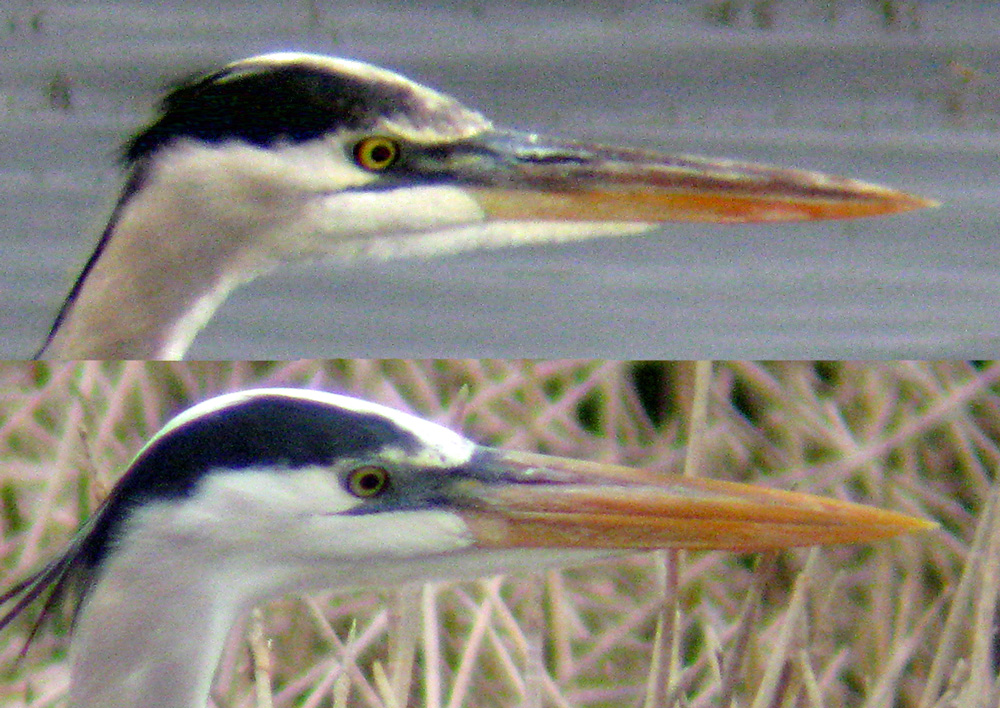Phenology is the study of the timing of natural events, and I have recently begun to realize how useful it is for distinguishing subspecies of birds. In San Diego in Mar 2009 I noticed differences in behavior and molt timing that were helpful in distinguishing Belding’s and Northern Savannah Sparrows. I wrote about this again with an additional example of Savanah Sparrow behavior in the Feb 2010 issue of Birder’s World: using behavior as an aid to identifying subspecies of birds (subscription required). And I mention molt timing as an aid to identifying Canada Geese in a post on Determining age in Canada Geese.
When I was in Florida recently I spent some time looking at Great Blue Herons, and noticed another difference that could be useful for distinguishing subspecies.
In Feb 2010 at Viera Wetlands, Brevard County, Florida, I noticed that some of the many Great Blue Herons there were already developing courtship colors – most conspicuously a bright orange bill – while others were still in nonbreeding colors. I then looked at them based on the assumption that the birds already in courtship colors in late January were local residents (subspecies A. h. wardii), while the drab-colored birds were more likely to be migrants that would nest months later and much farther north (subspecies A. h. herodias). When I sorted the birds by bill color, some other subtle differences were evident that may correspond to subspecies.

The birds with drab colors in late January appeared generally smaller and smaller-billed than the bright-billed birds. In the photo above I’ve adjusted the sizes to try to match head and eye size, although without measurements or direct comparison this is just an impression. There is also the potential pitfall that my field observations were biased because I was looking to confirm my hypothesis that the brighter-billed birds were larger. Finally, there is the possibility of an optical illusion: given two birds the same size, a more brightly-colored bill would appear larger.
Given those caveats, studying a few individuals in the field, the drab-colored birds did seem smaller and smaller-billed on average, with slightly darker and more brown-tinged necks and less white on the cheeks.
Another interesting difference that shows in these photos is the greater extent of feathering onto the base of the bill of the presumed northern bird. The feathering on the forehead of the upper bird extends farther forward and is more pointed (like Tundra Swan) and on the lower bird the forehead feathering does not extend out into a point (like Trumpeter Swan). The feathering at the base of the lower mandible also seems to extend farther onto the bill on the upper (presumed northern) bird.
Is this a real difference between northern and southern populations of Great Blue Heron? Could this be an adaptation to the cooler climates encountered by northern birds? Or is it just variable in all populations?
The differences are subtle, and this is only based on a few individuals, but I think the timing of breeding colors could be a very handy way to distinguish local breeders from northern migrants, and the differences are worthy of more study.
Note on subspecies:
There is a well-documented difference in size among Great Blue Herons of eastern North America – smaller and smaller-billed birds in the north to larger and larger-billed in the south. Whether the differences deserve subspecies names is open to debate. Some authorities name a northern and southern subspecies (herodias or treganzai and wardii respectively), with a dividing line around South Carolina, while others feel that the size differences are entirely clinal so any distinction is arbitrary, and call them all one subspecies (herodias) (Butler, 1992; Pyle, 2008).
Similar debate surrounds the naming of the population known as “Great White” Heron in extreme southern Florida, which I have written about here.
References:
Butler, Robert W. 1992. Great Blue Heron (Ardea herodias), The Birds of North America Online (A. Poole, Ed.). Ithaca: Cornell Lab of Ornithology; Retrieved from the Birds of North America Online:http://bna.birds.cornell.edu/bna/species/025
Pyle, P. 2008. Identification Guide to North American Birds: Part II. Slate Creek Press, Point Reyes Station, CA.


Stimulating – I move from NY to Lake Mary Fl and have had many opportunities to observe herons, egrets and other waders. Although I have noticed some of the variations you point out my notes are not as complete as now I think they should become in the future.
Size differences among great egrets are quite obvious and it has always puzzle me why field guides over look this or when they include a range of sizes it is much smaller than what I see in the filed. The same holds true for Great Blue Heron and other Ardeidae. I wrote the differences off to the growth of herons and egrets and sexual variations,
I would be interested in your thought on this bird that I saw in south Florida beside the Tamiami Trail (hwy 41).
https://www.flickr.com/photos/8459071@N08/51942824699/in/album-72177720297399541/
https://www.flickr.com/photos/8459071@N08/51943113740/in/album-72177720297399541/
https://www.flickr.com/photos/8459071@N08/51943112085/in/album-72177720297399541/